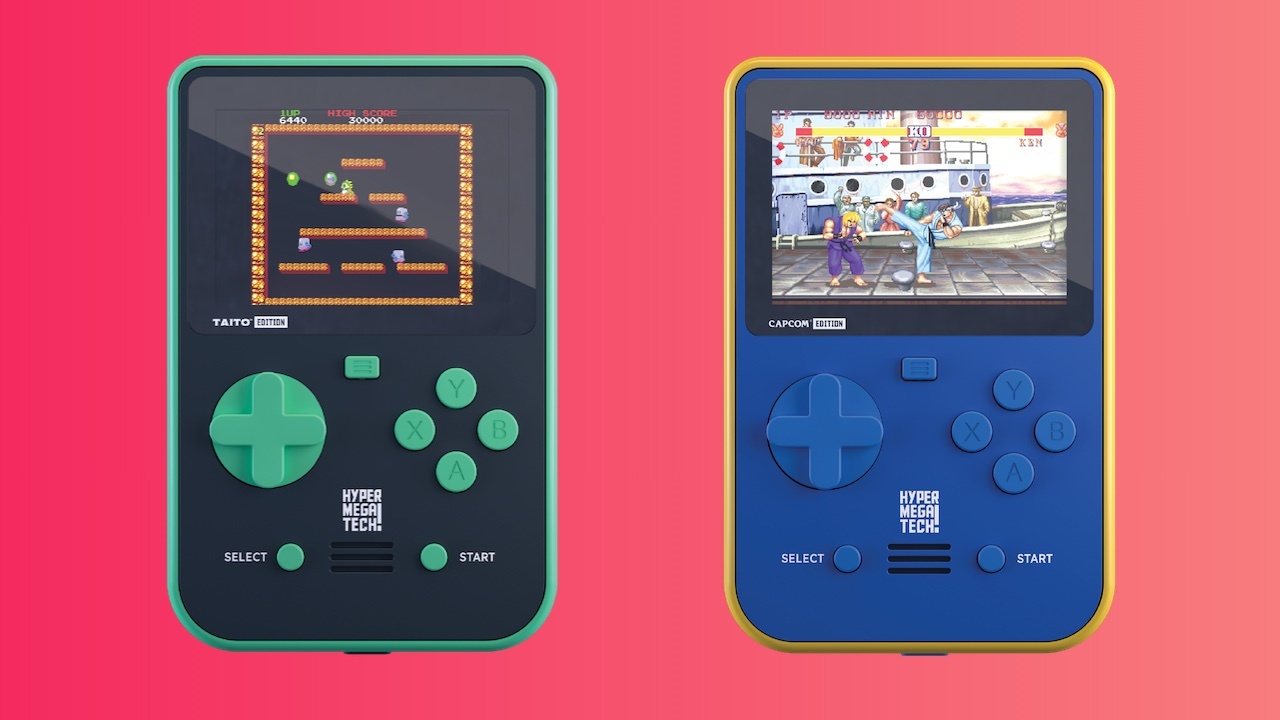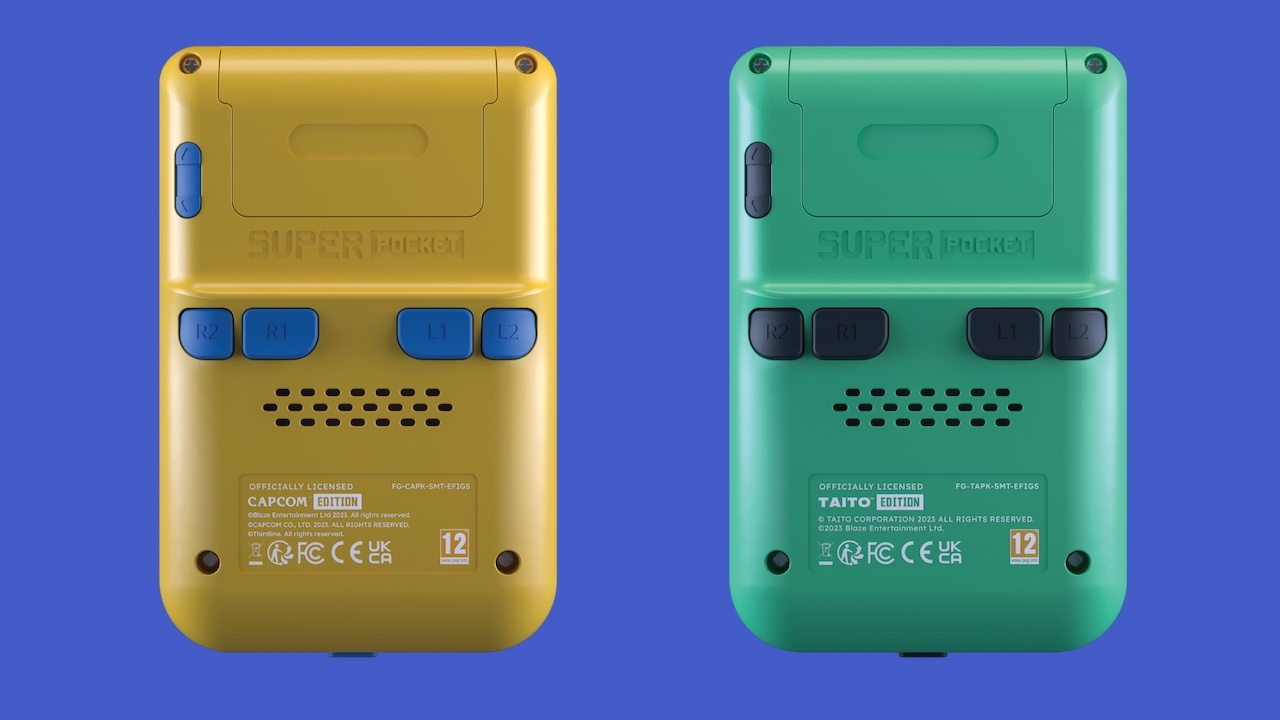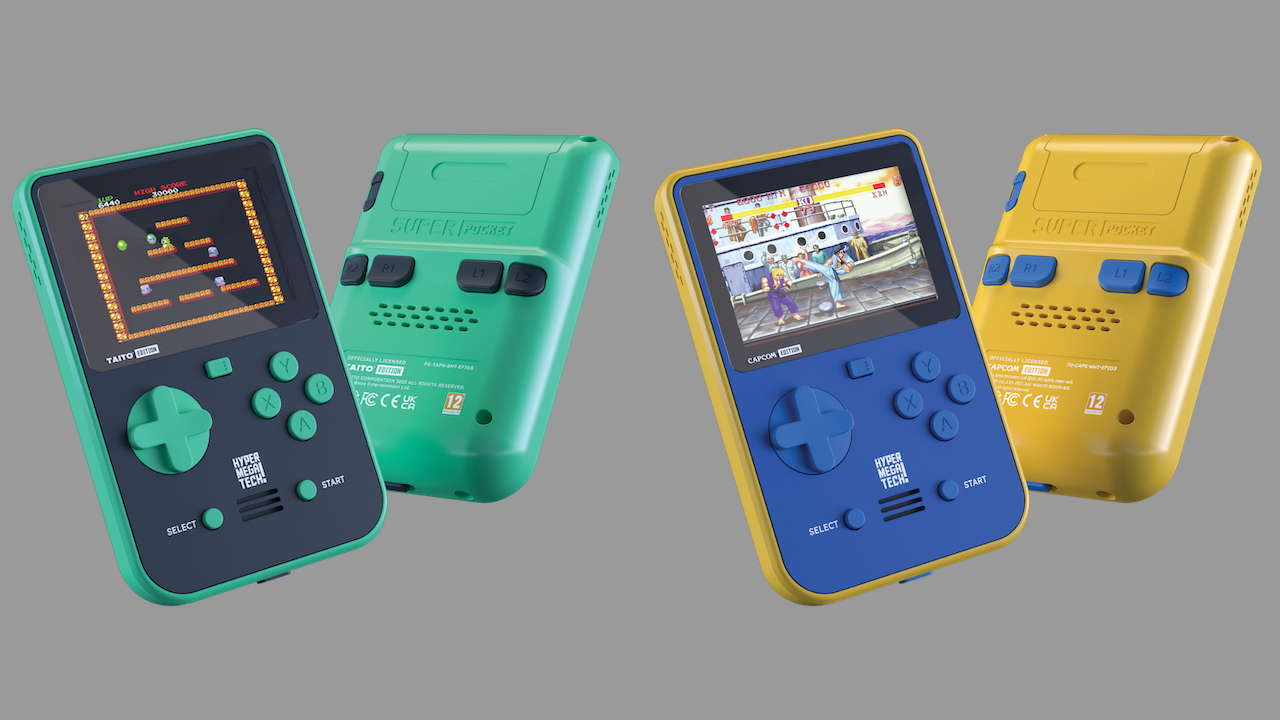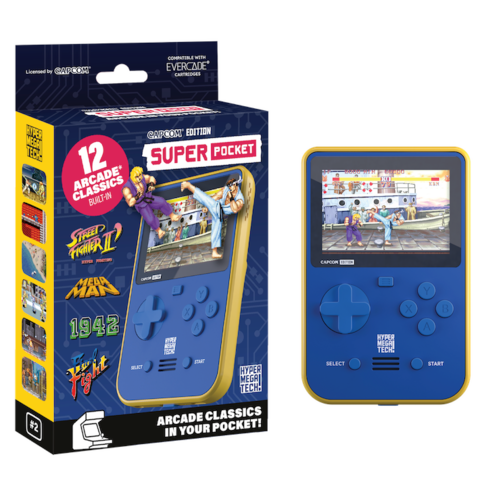With two handhelds, a home console, and 50-plus cartridge-based compilations (and counting) to its name already, Blaze Entertainment has built an impressive retro gaming ecosystem with its Evercade brand. Cornering an enthusiast sector of the industry was a smart move, and Blaze's latest retro hardware is its cleverest play yet. Branded under an offshoot of Evercade dubbed Hyper Mega Tech, the Super Pocket charmingly pays homage to the Game Boy. These truly pocket-sized handhelds--not always a given in today's portable market--offer tremendous value at just $60 a pop and would make for an awesome nostalgia gift this holiday.
You can choose between Capcom and Taito editions of the Super Pocket, each of which is officially licensed and available now at Amazon and Best Buy. The Capcom Super Pocket has a blue-and-yellow color scheme and comes preloaded with 12 classic Capcom games, whereas the Taito Super Pocket is green and black with 17 preloaded arcade classics. Both models look great and have approximately the same dimensions as the Game Boy Pocket (3 x 5 inches). Even the screen design nods back to the Game Boy, with the black borders and platform names in the lower-left corner, but naturally the 2.8-inch 320x240 IPS panel is much nicer.
The Super Pocket would offer solid value even if it only played the preloaded games. On the Capcom side, you're getting beloved hits like Mega Man, Street Fighter 2, Ghouls 'n Ghosts, Strider, and 1942. The Taito version comes with iconic arcade games like Space Invaders and Bubble Bobble. But these handhelds utilize the strength of the Evercade brand. Though it ditches the Evercade name, the Super Pocket retains the ability to play the official cartridges. As a result, it's more than a novelty device to play from time to time--I'm looking at you Mario and Zelda Game & Watches. The Super Pocket is a full-fledged, evolving platform.

Both handhelds come with a dummy cart that sits flush in the game slot, so it won't look weird if you don't buy cartridge games. If you're interested in expanding your library, Evercade carts retail for around $20, and the vast majority contain at least a handful of games. Over the past three-plus years, Blaze has released a wide assortment of officially licensed cartridges across three series: console, arcade, and home computer.
There are compilations focused on specific platforms like Atari and Intellivision as well as many that feature games from studios such as Data East, Codemasters, Namco, Jaleco, Interplay, Sunsoft, and Technos. While most cartridges center on classics, a growing number of contemporary "retro" games have joined the library, including Alwa's Awakening, Xenocrisis, Tanglewood, and many games from Mega Cat Studios, which is one of the most prolific developers of new games for old hardware. This month saw the release of the standout cinematic platformer Full Void, and multiple exciting launches are on the horizon. Goodboy Galaxy, a brand-new Game Boy Advance metroidvania, will be bundled with Witch n' Wiz, a modern NES puzzle-platformer. A pair of Duke Nukem collections release this month, too. What's particularly noteworthy here is that Duke Nukem 1 and 2 received official remasters. That cartridge also includes Duke Nukem 3D, while the second collection features a trio of Duke Nukem games.
All Evercade carts perform as they do on the original Evercade and Evercade EXP, Blaze's premium handheld that retails for $150. That's mighty impressive for a $60 handheld. Though the Super Pocket doesn't offer as high of resolution as its older siblings, retro games still look great on the smaller IPS screen.
Of course, the option to expand the library wouldn't be too appealing if the Super Pocket didn't offer a good overall experience. But just like the Evercade handhelds, the Super Pocket is a well-made device. Sturdy and lightweight with a smooth matte finish, almost nothing about it feels cheap. It doesn't have any of those little creaks or rattles that you might expect with budget-friendly electronics.

The button layout cleverly avoids the common pitfall of small portable devices: subpar ergonomics. Along with the eight-way D-pad and four face buttons, the Super Pocket has four back buttons that serve as triggers and shoulder buttons. The back buttons are positioned exactly where my index fingers naturally rest. Meanwhile, the contoured edges leading to the back make it more ergonomically friendly than the conventional boxy, angular form factor. This subtle choice makes a noticeable difference on your palms. I've played for multiple hours straight on numerous occasions, and my hands or fingers have yet to cramp up.
The one aspect of the build that falls a bit short is the D-pad. It's responsive and accurate, but it's also fairly rigid. Considering the D-pad on the Evercade EXP is a standout feature--it's one of the best D-pads around--it's disappointing the Super Pocket's is average, especially since the face buttons and triggers have a soft yet sturdy quality that feels pretty darn good.
The Super Pocket also borrows its operating system from the Evercade line. It's a stripped-down version with a snappy, more streamlined menu system. The preloaded games have their own menu, with each title represented with its cover art in a carousel. You can press the menu button to pull up a side panel and switch to the cartridge-based games. When playing a game, the button opens a list of key settings, including saving/loading functions. Save states allow you to bookmark your spot at any point, and each game has six slots that can be loaded in a flash.
Like many retro consoles and handhelds, there are numerous display options. By default, games are presented in the original aspect ratio. You can switch to pixel-perfect and full-screen layouts on the fly--though some games are in full screen by default. You can also add subtle or strong scan lines if you're aiming for the authentic CRT TV look.

A neat feature for the preloaded Taito and Capcom games is difficulty settings. You can either play as originally intended, or you can turn on easy mode for a friendlier experience. This is particularly nice for those who want to introduce youngsters to the games they loved as kids. After all, many games from that era are unforgiving.
For a small and affordable device, the Super Pocket has surprisingly solid stereo audio. It can get quite loud and remains crisp (no crackling) at high volumes. Alternatively, it has a 3.5mm jack on the bottom for headphones. Catchy home screen music plays on a loop, but it's possible to turn it off in the sound menu. There, you can adjust menu sound effects/music as well as the master volume. A two-way button on the back of the Super Pocket controls speaker volume. Outside of the headphone jack, the only other port is USB-C. On a full charge, I averaged just north of four hours of playtime.
Current Evercade EXP (and VS home console) owners should be aware that some features are absent here. Most notably, it doesn't have a mini-HDMI port, so you can't connect it to your TV or monitor. It also lacks Wi-Fi, so it probably won't receive operating system updates like the Evercade systems. This also means you don't get to play the monthly free game that's added with system updates. Unlike on Evercade, there's only one theme, and the quick menu with descriptions for each game is gone. With the Super Pocket, you have to load your save states within each game, rather than a dedicated system menu. Additionally, you won't find the "secrets" menu, which unlocks bonus games with codes, on the Super Pocket.
Check out the Evercade lineup:
- Evercade EXP handheld -- $134 (
$150) - Evercade VS Starter Pack -- $100
- Evercade VS Premium Pack -- $105 (
$130)
Overall, the core Evercade experience translates well to the Super Pocket. But does it make sense for Evercade owners to add a Super Pocket to their collection? It depends what you're looking for. The Super Pocket, more so than either Evercade handheld, will fit in your pocket no problem. Evercade EXP owners already have preloaded Capcom games (and more of them), so it would make more sense to get the Taito Super Pocket in that scenario. And if you're an original Evercade owner, you'd have to decide how much you care about the Game Boy-esque form factor and the games that come with the Super Pockets.
The bottom line
If you're new to this ecosystem of retro handhelds, you'll be treated with a great little handheld at a startlingly low price. At $60, the genuinely pocketable Super Pocket is one of the best value buys for retro enthusiasts, regardless of which model you buy. It punches above its weight thanks to a sound build quality, lovely presentation, and reliable performance. The vast and steadily growing Evercade cartridge library makes it an impressive low-cost entry point to a wonderful ecosystem. Much like the Evercade, the Super Pocket is a top-notch portable crafted with noticeable care and respect given to the hardware and games it celebrates.
Capcom Edition Super Pocket
$60
The Capcom Super Pocket comes with 12 preloaded games:
- Street Fighter II: Hyper Fighting
- Mega Man
- 1942
- Ghouls ‘n Ghosts
- Final Fight
- Strider
- 1943
- 1944 : The Loop Master
- Bionic Commando
- Captain Commando
- Forgotten Worlds
- Wolf of the Battlefield: Merc
Taito Edition Super Pocket
$60
- Space Invaders
- Bubble Bobble
- Puzzle Bobble
- Operation Wolf
- The NewZealand Story
- Rastan
- Cadash
- Chack'n Pop
- Don Doko Don
- Elevator Action
- The Fairyland Story
- Football Champ
- Growl
- Kiki Kaikai
- The Legend of Kage
- Liquid Kids
- Space Invaders '91
- Volfied
Blaze Entertainment provided Capcom and Taito Super Pocket handhelds to GameSpot to test for this review.


